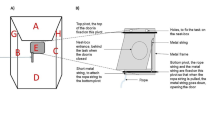Abstract
Neurodegen erative disorders such as Alzheimer’s disease (AD) are increasingly threatening public health. Most animal models of AD consist of transgenic mice that are usually housed singly or in unisexual groups in small barren cages. Such restricted environments, however, prevent the mice from showing a variety of speciesspecific behaviors and consequently may constrain comprehensive behavioral phenotyping. On the other hand, allowing the animals to freely organize their lives in a spacious physically and socially enriched environment makes behavioral phenotyping laborious and time consuming. Radio frequency identification (RFID) using a network of antennae and small glass-coated transponders labeling each individual allows for gathering spatiotemporal information about a large number of individuals in parallel. The aim of this project was to use the RFID technique to facilitate the characterization of mice carrying a genetic disposition to develop AD-like pathology and of their wild-type conspecifics in a spacious seminaturalistic environment.
Similar content being viewed by others
References
Albers, P. C. H., & de Vries, H. (2001). Elo-rating as a tool in the sequential estimation of dominance strengths. Animal Behaviour, 61, 489–495. doi:10.1006/anbe.2000.1571
Ambrée, O., Touma, C., Görtz, N., Keyvani, K., Paulus, W., Palme, R., & Sachser, N. (2006). Activity changes and marked stereotypic behavior precede Aβ pathology in TgCRND8 Alzheimer mice. Neurobiology of Aging, 27, 955–965. doi:10.1016/ j.neurobiolaging.2005.05.009
Barnes, C. A. (1979). Memory deficits associated with senescence: A neurophysiological and behavioral study in the rat. Journal of Comparative & Physiological Psychology, 93, 74–104.
Chishti, M. A., Yang, D.-S., Janus, C., Phinney, A. L., Horne, P., Pearson, J., et al. (2001). Early-onset amyloid deposition and cognitive deficits in transgenic mice expressing a double mutant form of amyloid precursor protein 695. Journal of Biological Chemistry, 276, 21562–21570. doi:10.1074/jbc.M100710200
de Visser, L., van den Bos, R., Kuurman, W. W., Kas, M. J. H., & Spruijt, B. M. (2006). Novel approach to the behavioural characterization of inbred mice: Automated home cage observations. Genes, Brain, & Behavior, 5, 458–466. doi:10.1111/j.1601-183X.2005.00181.x
Dunn, S. M. (1998). Software review: Optimas 6.5. Journal of Computer-Assisted Microscopy, 10, 53–54.
Galsworthy, M. J., Amrein, I., Kuptsov, P. A., Poletaeva, I. I., Zinn, P., Rau, A., et al. (2005). A comparison of wild-caught wood mice and bank voles in the Intellicage: Assessing exploration, daily activity patterns and place learning paradigms. Behavioural Brain Research, 157, 211–217. doi:10.1016/j.bbr.2004.06.021
Gerlach, G. (1996). Emigration mechanisms in feral house mice: A laboratory investigation of the influence of social structure, population density, and aggression. Behavioral Ecology & Sociobiology, 39, 159–170. doi:10.1007/s002650050277
Görtz, N., Lewejohann, L., Tomm, M., Ambrée, O., Keyvani, K., Paulus, W., & Sachser, N. (2008). Effects of environmental enrichment on exploration, anxiety, and memory in female TgCRND8 Alzheimer mice. Behavioural Brain Research, 191, 43–48. doi:10.1016/ j.bbr.2008.03.006
Janus, C., Pearson, J., McLaurin, J., Mathews, P. M., Jiang, Y., Schmidt, S. D., et al. (2000). Aβ peptide immunization reduces behavioural impairment and plaques in a model of Alzheimer’s disease. Nature, 408, 979–982. doi:10.1038/35050110
Kritzler, M., Lewejohann, L., Krüger, A., Raubal, M., & Sachser, N. (2006). An RFID-based tracking system for laboratory mice in a semi-natural environment. Paper presented at the PERVASIVE 2006 Workshop—Pervasive Technology Applied Real-World Experiences With RFID and Sensor Networks, Dublin.
Lanari, A., Amenta, F., Silvestrelli, G., Tomassoni, D., & Parnetti, L. (2006). Neurotransmitter deficits in behavioural and psychological symptoms of Alzheimer’s disease. Mechanisms of Ageing & Development, 127, 158–165. doi:10.1016/j.mad.2005.09.016
Lewejohann, L., Reefmann, N., Widmann, P., Ambrée, O., Herring, A., Keyvani, K., et al. (2009). Transgenic Alzheimer mice in a semi-naturalistic environment: More plaques, yet not compromised in daily life. Behavioural Brain Research, 201, 99–102. doi:10.1016/j.bbr.2009.01.037
Lewejohann, L., Skryabin, B. V., Sachser, N., Prehn, C., Heiduschka, P., Thanos, S., et al. (2004). Role of a neuronal small non-messenger RNA: Behavioural alterations in BC1 RNA-deleted mice. Behavioural Brain Research, 154, 273–289. doi:10.1016/j.bbr.2004.02.015
Lloyd, J. A. (1975). Social structure and reproduction in two freelygrowing populations of house mice (Mus musculus L.). Animal Behaviour, 23, 413–424. doi:10.1016/0003-3472(75)90089-5
Mackintosh, J. H. (1970). Territory formation by laboratory mice. Animal Behaviour, 18, 177–183.
Marshall, G. A., Fairbanks, L. A., Tekin, S., Vinters, H. V., & Cummings, J. L. (2006). Neuropathologic correlates of activities of daily living in Alzheimer disease. Alzheimer Disease & Associated Disorders, 20, 56–59. doi:10.1097/01.wad.0000201852.60330.16
Martin, P., & Bateson, P. (1993). Measuring behaviour: An introductory guide (2nd ed.). Cambridge: Cambridge University Press.
Nelson, A. R., Johnson, C. L., Matter, W. J., & Mannan, R. W. (2002). Tests of emigration in small mammals under experimental conditions. Canadian Journal of Zoology, 80, 2056–2060. doi:10.1139/z02-193
R Development Core Team (2008). R: A language and environment for statistical computing (Version 2.6.2). Vienna: R Foundation for Statistical Computing.
Sapolsky, R. M. (2005). The influence of social hierarchy on primate health. Science, 308, 648–652. doi:10.1126/science.1106477
Sebastiani, G., Krzywkowski, P., Dudal, S., Yu, M., Paquette, J., Malo, D., et al. (2006). Mapping genetic modulators of amyloid plaque deposition in TgCRND8 transgenic mice. Human Molecular Genetics, 15, 2313–2323. doi:10.1093/hmg/ddl157
Touma, C., Ambrée, O., Görtz, N., Keyvani, K., Lewejohann, L., Palme, R., et al. (2004). Age- and sex-dependent development of adrenocortical hyperactivity in a transgenic mouse model of Alzheimer’s disease. Neurobiology of Aging, 25, 893–904. doi:10.1016/ j.neurobiolaging.2003.09.004
von Holst, D. (1998). The concept of stress and its relevance for animal behavior. In A. P. Møller, M. Milinski, & P. J. B. Slater (Eds.), Advances in the study of behavior 27: Stress and behavior (pp. 1–131). San Diego: Academic Press.
Author information
Authors and Affiliations
Corresponding author
Rights and permissions
About this article
Cite this article
Lewejohann, L., Hoppmann, A.M., Kegel, P. et al. Behavioral phenotyping of a murine model of Alzheimer’s disease in a seminaturalistic environment using RFID tracking. Behavior Research Methods 41, 850–856 (2009). https://doi.org/10.3758/BRM.41.3.850
Received:
Accepted:
Published:
Issue Date:
DOI: https://doi.org/10.3758/BRM.41.3.850




